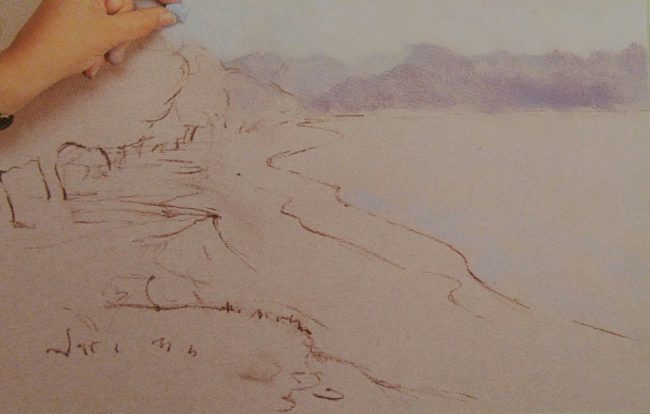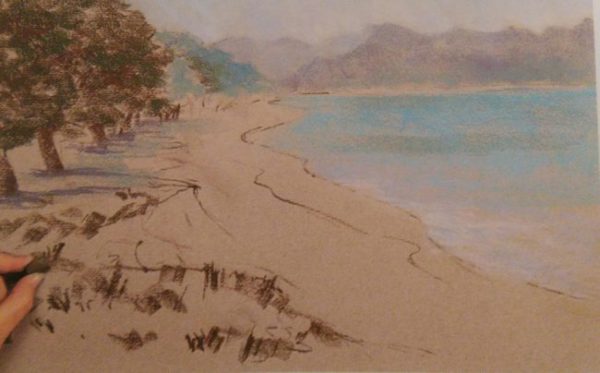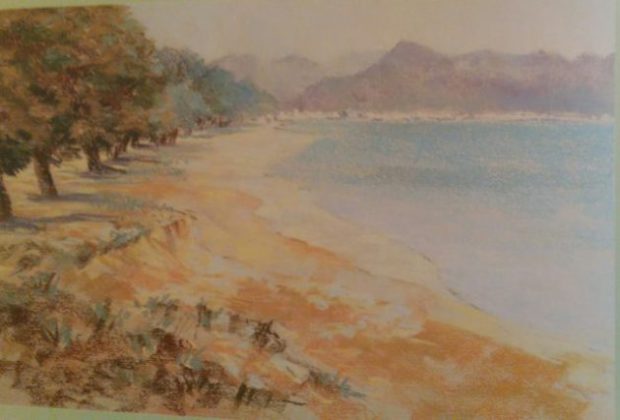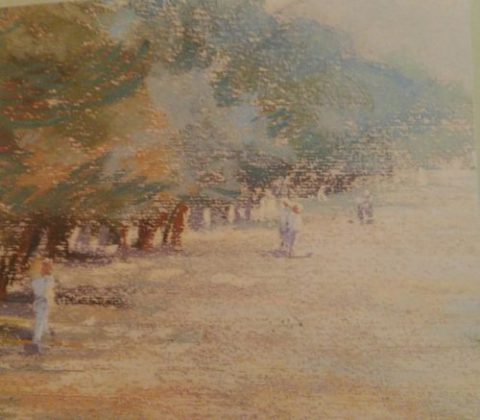Maybe the biggest challenge for any landscape artist is creating depth and impression of space on a flat piece of paper. The most effective mean in achieving the depth and sense of space on your drawing is the use of colour and tone in such a manner to create effects of live atmospheric perspective.
I will try to explain how to draw landscapes with such an impression using soft pastel pencils. Atmospheric perspective is an expression that describes natural optical illusion caused by the presence of particles of dust and vapour in the atmosphere which makes the colours and shapes look blurry and less distinct the closer to the horizon they get.
As your eyes wander from the front plane to the horizon you will notice certain changes in the look of the landscape. For example, the colours in the front plane will appear worm and shiny but gradually they will become more neutral and less intense as farther you go and near the horizon, they will often appear bluish.
Tone and contrast appear to be strongest in the front plane becoming blurry and less clear in the distance.
In order to create the illusion of depth and space in your landscape, all you have to do is to create the above-mentioned effects. Use strong bright tones in front plane and as you go deeper in your drawing use darker and colder colours to finish with the coldest ones.

Beach
On this landscape of the coast, there is a strong sense of depth and space. The front plane is detailed and made with strong tones and bright colours. The further back you go the distinction in lines between the tones gets softer and the colours start to become paler and colder pushing the far away mountains deeper in space.
For this drawing you will need the following:
- A sheet of pastel paper in warm grey tone
- Charcoal stick
- Spray fixative
And the following soft pastel colours:
- Dark red-brown
- Dark green
- Purple
- Purple-grey
- Terracotta
- Pale pink
- Olive green
- A middle nuance of yellow-green
- Light yellow-green
- Light raw sienna
- Pale yellow
- pale golden yellow
- Grey-blue
- Turquoise blue
- Pale blue
- Dark blue
- Pale cream
- Brown Ochre
- Orange



Sketching
Sketch the main contour of the composition using a charcoal stick. When you’re satisfied with your sketch spray a bit of fixative spray on it to prevent the charcoal from smearing. Cover the mountains in the distance with colour using purple and purple-grey. Break little bits of pastel and draw using the side of it overlapping the colours trying to do so with completely relaxed moves.
Draw the sky overlapping very pale purple and blue tones and smear them with your fingers. Add a bit of palest blue pastel on the brightest areas of the sea. Using the same colour go over some areas on the mountains creating the expression of morning haze.
Cover the sea with strokes of turquoise blue and grey-blue adding the colour with the side of the pastel pencil. Add just a glimpse of pale purple to the sea to point out shallows next to the shore. Use grey-blue pastel for grassy areas under the trees and to draw the trees in the distance.
Draw the treetops of the nearest trees with short scattered moves using warm olive green adding a bit of darker green here and there for leaves in the shadows.
Use dark red-brown to draw the tree stems and using the same colour add shade to the treetops. To add dark shades under the trees use a purple pastel pencil and draw with relaxed moves.
Add a little bit of olive green in the grassy area in the front plane of the drawing using both the side and the tip of the pastel pencil.



Adding the details
Start working on building the texture of the beach using orange, terracotta, pale pink and pale cream pastel pencils to depict smaller and bigger pebbles. Overlap the colours but still draw with relaxed moves in this phase of drawing. Use short moves to draw rough grass with olive green pastel pencil.
With short moves add brown ochre in the front plane in order to achieve texture and depict the bushes. Keep adding layers of colour on the trees using at first brown ochre and then moves of turquoise blue for lighter areas. Go over the beach with pale yellow but leave the grey paper uncoloured here and there.
Apply more pressure on the paper on some areas to create the contrast. Continue working on the beach with pale yellow in the frontal plane. Add glimpses of the buildings in the back area of the drawing using pale purple.
Add smears of pale blue and turquoise along the shore and on the bushes but make sure that warm colours are dominant. with relaxed moves add dark red-brown in the closest area of the front plane. Add some more moves with dark blue on to the tree tops.
Finishing touches
Build the details in the front plane by adding dots and smears of gold colour to create the impression of small pebbles. Using the same pastel pencil add details on the beach in order to even up the colours.
Draw the tiny human figure that’s strolling down the beach underneath the trees using pale blue and cream for the body and terracotta pastel pencil for the head.
With dark blue and purple work
Add two more pairs of human figures further down the beach with short moves and smears of light blue and purple adding pale yellow for light areas on them. For the shadows, they cast use a purple pastel pencil. Smaller figures suggest the depth and their position draws the eyes into it.
Go over the frontal area of the drawing with raw sienna pastel pencil letting the other already existing colours seen through it. Work on the shape of the mountains using blue-grey and in the end, add light moves of turquoise blue across the sky and water.
If you have any questions regarding the subject leave them below and I will be more than happy to answer.





0 Comments